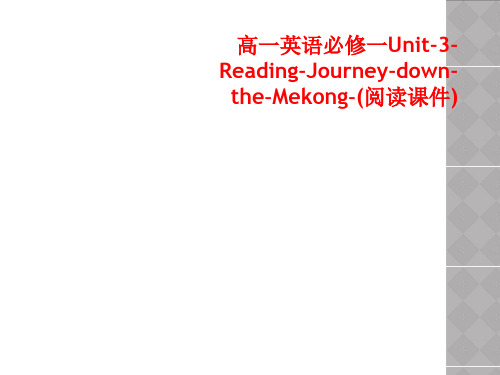高一英语必修一Unit 3 Reading Journey down the Mekong (language points)
- 格式:ppt
- 大小:296.00 KB
- 文档页数:36


高一英语必修一Unit 3课文翻译Unit 3 Travel journalReadingJOURNEY DOWN THE MEKONG沿湄公河而下的旅程PART 1 THE DREAM AND THE PLAN第一部分梦想与计划My name is Wang Kun. Ever since middle school, my sister Wang Weiand I have dreamed about taking a great bike trip.我的名字叫王坤。
从高中起,我姐姐王薇和我就一直梦想作一次伟大的自行车旅行。
Two years ago she bought an expensive mountain bike and then she persuaded me to buy one.两年前,她买了一辆昂贵的山地自行车,然后还说服我买了一辆(山地车)。
Last year, she visited our cousins, Dao Wei and Yu Hang at their college in Kunming.去年她去看望了我们的表兄弟——在昆明读大学的刀卫和宇航。
They are Dai and grew up in western Y unnan Province near the Lancang River, the Chinese part of the river that is called the Mekong River in other countries.他们是傣族人,在云南省西部靠近澜沧江的地方长大,湄公河在中国境内的这一段叫澜沧江,在其他国家(境内)叫湄公河。
Wang Wei soon got them interested in cycling too.很快,王薇使表兄弟也对骑车旅游产生了兴趣。
After graduating from college, we finally got the chance to take a bike trip.大学毕业以后,我们终于有了机会骑自行车旅行。




青州八中英语学科导学案年级:高一主备人:隋丽云审核人:李春刚使用人:高一全体编号: 2009 年 10 月日课题Unit 3 Journey down the Mekong 课型reading教材分析目标To master the words and phrasesTo retell the passageTo know the background of the Mekong重点W ords and phrases难点Comprehending and retelling the text教学过程个性空间Step Ⅰ. Reading the words and expressionsStep Ⅱ. Leading-inDo you like traveling? Why do you like traveling? And why not?Where have you ever been before? How did you get there?If you are given a chance to travel around the world, what kind of f transportations will you use and why?Step Ⅲ. SkimmingRead the passage quickly and find the topic sentence of each paragraph: Type of writing This is a travel journalTopic sentence of 1st paragraphTopic sentence of 2nd paragraphTopic sentence of 3rd paragraphStep Ⅳ. Careful -reading1.What was Wang Kun and Wang Wei’s idea of a good trip?2.Who planned the trip to the Mekong?3.Where is the source of the Mekong and which sea does it enter?4.What can you see when you travel along the Mekong?5.What difficulties did Wang Kun and Wang Wei find about their journey?6.What do you think about Wang Kun and Wang Wei?Step Ⅴ. Retelling the story in the third personWang Kun and his sister Wang Wei have taking a great bike trip their middle school days. After from college, they to cycle along the Mekong River. Wang Wei also got their cousins Dao Wei and Yu Hang interested in , too. It was Wang Wei first had the ideas to along the Mekong River from to . Now she is planning their for the trip.Wang Kun his sister but she has one serious . She was a girl. she didn’t know the best way of getting to places, she that she the trip properly. She doesn’t details. So Wang Kun told her that the of the Mekong River was in Qinghai. She gave Wang Kun a look-the kind that said she wouldn’t. When Wang Kun told Wang Wei that their would begin at an of more than 5000 meters, she seemed to be excited about it. She also thought that it would be an interesting . Once she has , nothing can change it. Her brother couldn’t her. At last, her brother had to .Before the trip, they went to the library, where they found a large with good maps. From the atlas, they learnt more information about the Mekong River.Step Ⅵ. Retell the story according to the key words and phrases.Wang Kun and his sister…middle school…after graduating…got the chance to…thought of the idea…cycle…the Mekong River…got sb. interestedin…journey…begin at an altitude of…change one’s mind…atlas…in the libraryStep Ⅶ. Homework1. Read the text again and review the meaning and usage of the key words and phrases:transport, prefer, disadvantage, fare, flow, ever since, persuade, cycle, graduate, schedule, be fond of, shortcoming, stubborn, organize, care about, determined, change one’s mind, journey, altitude, make up one’s mind, give in, valley, pace, bend2. Write the passage down in the notebook.课堂总结。
Module1 Unit3Journey down the Mekong英语组:XXX一、教材的分析与处理1、课型:阅读课2、教材分析:地位:本文是该单元“旅行日志”的重点文章,属精读材料。
内容:讲述了主人公与姐姐想骑山地车沿湄公河沿线旅行,并为此查阅资料做准备。
体裁:旅行日记3、学生分析:学生已经学了warming-up与部分单词,并且预习了这篇课文,上课会比较轻松,理解也比较容易。
4、教学目的要求:①语言知识:理解与旅游有关的知识并掌握文中的一些词汇短语。
②语言技能:培养阅读策略(跳读、寻读、略读等);了解旅游前的准备。
③情感态度:学习王薇敢于冒险的精神;感受主人公认真谨慎的态度,养成做事充分准备坚持到底的好习惯。
④学习策略:学会出行之前讨论、制定计划、查阅旅游资料等能力。
⑤文化意识:增强对祖国大好河山的热爱,以及在旅游中接受异国文化的能力。
5、教学重点:提升学生篇章的整体理解能力,让学生理解本课旅游日记的内容。
6、教学难点:(1)利用跳读、寻读等策略来找出关键词或主题句。
(2)以阅读课为依托,训练学生听、说、读、写及小组合作的能力。
二、教学方法与手段1、教学方法与手段:任务型教学法,情景教学法,讲授法。
(1)通过设置情景和教师讲授,帮助学生了解和学习关于湄公河的信息,激发学生的兴趣,为学习课文做铺垫。
(2)运用任务型教学法,通过读前、读中、读后的任务设计,引导学生理解文章的内容。
2、教学辅助:多媒体三、教学过程Step1: Lead inAsk some students to present their dialogue.(The homework of last class)【设计说明】采用对话形式导入,营造出宽松的学习气氛,为学生全面的课堂参与作了铺垫。
Step2: Pre-readingShow students some pictures and maps to know more about the Mekong river, its two names and the route it flows out of China.1. Names: Lancang River and Mekong River2. Route: China-Myanmar-Laos-Thailand-Cambodia-Vietnam-South China sea 【设计说明】利用图片来了解湄公河,为课文第三段做铺垫,同时,激发了学生的兴趣和好奇心。
人教版Unit3 Reading Journey down the Mekong教学设计辽宁师大附中庞春艳一、教材分析本课是人教版必修一第三单元的一篇阅读课。
文章是一篇记叙文,主人公王坤以旅行日志的形式讲述了和姐姐王薇想骑山地车旅行,并为这次旅行查阅资料做准备的过程。
文中的湄公河在中国境内被叫做澜沧江,是一条跨越六个国家的国际性河流。
湄公河海拔5000多米,空气稀薄,他们所选择的旅行路线注定是一次非常刺激的旅行经历。
本篇文章为后面的游记提供了背景知识,是本单元的重点文章,属精读内容。
二、学情分析我所授课的年级为高一学生,他们在经过了将近一个月的高中生活后基本适应了高中的英语教学模式。
另外,人们对于旅游这个话题都非常感兴趣,尤其是他们这个年龄段的孩子,有热情,敢于冒险。
但是高一学生对阅读技能的掌握需要一点点培养,所以在设计课的过程中,要考虑阅读技能的训练。
三、教学目标Teaching objectives1.Knowledge and skills:Students will be able to1)pick out useful information and get the main idea of the reading passage.2)develop their reading ability by skimming, scanning and so on.3)understand and master some words and expressions related to geography.4)give a description of the Mekong River and know how to make a plan for a trip2.Emotional attitude and valueStudents will be able to1)have a basic knowledge of the background of the Mekong River and develop an interest in traveling.2)get into a good habit of being prepared and persistent.四、教学重点The training of the reading skills and the full understanding of the text五、教学难点The analysis of the characters of Wang Kun and Wang Wei and how to give a description of the Mekong River六、教学方法Communicative strategy, task-based strategy, cooperative learning七、教学过程【体现教学目标达成、教学重难点突破、教法学法说明】八、 板书设计。